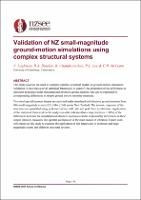| dc.contributor.author | Loghman, Vahid | |
| dc.contributor.author | Bradley, Brendon | |
| dc.contributor.author | Chandramohan, Reagan | |
| dc.contributor.author | Lee, Robin | |
| dc.contributor.author | McGann, Christopher | |
| dc.date.accessioned | 2021-06-22T04:01:53Z | |
| dc.date.available | 2021-06-22T04:01:53Z | |
| dc.date.issued | 2021-04-14 | |
| dc.identifier.uri | https://repo.nzsee.org.nz/xmlui/handle/nzsee/2362 | |
| dc.description.abstract | This study assesses the need to consider complex structural models in ground-motion simulation validation. It develops a novel statistical framework to quantify the proportion of the differences in structural responses under simulated and observed ground motions that can be explained by corresponding differences in simple ground motion intensity measures.
Two steel special moment frames are analysed under simulated and observed ground motions from 496 small-magnitude events (3.5 ≤ Mw ≤ 5.0) across New Zealand. The seismic responses of the structures are quantified using peak inter-storey drift ratio and peak floor acceleration. Application of the statistical framework to the analysis results indicates that a large fraction ( > 90%) of the differences between the simulated and observed responses can be explained by differences in their simple intensity measures like spectral acceleration at the main modes of vibration. Future work will extend on this study to examine the application of this framework to moderate and large magnitude events and different structural systems.
| |
| dc.language.iso | en | |
| dc.publisher | New Zealand Society for Earthquake Engineering | |
| dc.relation.ispartofseries | 2021;0046 | |
| dc.subject | Innovative approaches in seismic design and assessment | |
| dc.title | Validation of NZ small-magnitude ground-motion simulations using complex structural systems | |
| dc.type | Article | |

